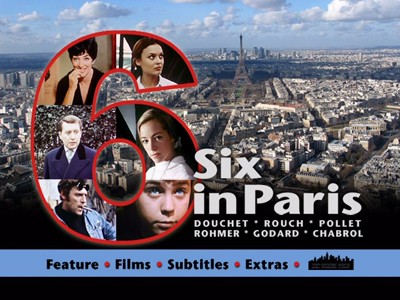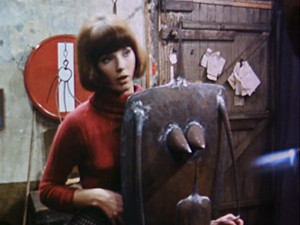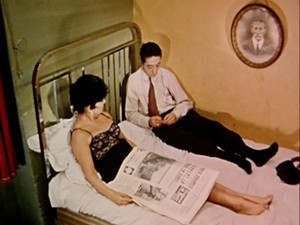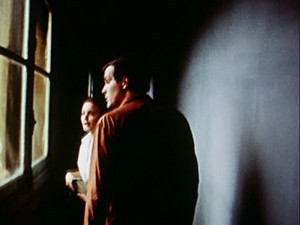| Reviews & Columns |
|
Reviews DVD TV on DVD Blu-ray 4K UHD International DVDs In Theaters Reviews by Studio Video Games Features Collector Series DVDs Easter Egg Database Interviews DVD Talk Radio Feature Articles Columns Anime Talk DVD Savant Horror DVDs The M.O.D. Squad Art House HD Talk Silent DVD
|
DVD Talk Forum |
|
|
| Resources |
|
DVD Price Search Customer Service #'s RCE Info Links |
|
Columns
|
|
|
Six in Paris
THE MOVIE:

A city is a living entity with a pulse, and to capture its true character requires multiple points of view, encompassing different neighborhoods and lifestyles. This was certainly part of what made last year's Paris, Je T'aime so invigorating, how it allowed a large collective of artists to give their individual impressions of Paris. So, too, in 1965 did producer Barbet Schroeder recruit a sextet of the best and brightest of French cinema to make Six in Paris, an anthology film with entries from Jean Douchet, Jean Rouch, Jean-Daniel Pollet, Eric Rohmer, Jean-Luc Godard, and Claude Chabrol.
Each filmmaker picks a neighborhood and each takes approximately fifteen minutes to share a story out of that neighborhood. A pair of them, Douchet and Rohmer, add a little extra historical context to their stories, shooting the beginning of the segments like tourism videos, but the rest dig right in and get to work. There is no unifying theme to the six pieces, though they are all linked by their humanist concerns. Even when we are shown images of the area, the background is dropped rather quickly to move inside and meet the people who give the neighborhoods their character. Most of the stories involve couples, all of them wrestling with their private desires and the quiet desperation of everyday life. Only Rohmer breaks from the model, showing his lonely sales clerk (Jean-Michel Rouziere) wandering through the center of Paris without making any real connections. Chabrol follows suit, after a fashion, with his concluding piece, "La Muette," focusing on the child (Gilles Chusseau) of a battling couple and the isolation the boy imposes on himself to escape their constant bickering. Chabrol's, like many of the other pieces, is darkly comic, satirizing the violence and lust lurking in suburban homes. Jean-Daniel Pollet also gives us a little taste of the tragedy inherent in comedy, and his "Rue Saint-Denis" one-act shows a sexually naive dishwasher (Claude Melki, whose long face and wide eyes make him look like Buster Keaton) having a domestic night in with a world-weary prostitute (Micheline Dax).
Of the six, though, my favorites are the second and the second to last. Jean Rouch's "Gare du Nord" features two parallel conversations in one morning. A young newlywed couple for whom the honeymoon has rapidly passed begin their day arguing over the urban sprawl that is threatening to box them in. The wife, Odile (Nadine Ballot), worries that the construction that is going on across the street from their high-rise apartment will soon bar them from seeing the rest of Paris from their window. Her indifferent husband (Barbet Schroeder) doesn't necessarily deny the problem, but his willingness to accept what he believes he cannot change points to a future of quiet complicity that seems stifling. Yet, out on the street, when Odile meets an intriguing stranger (Gilles Queant), her failure to snatch an opportunity for adventure looks equally as hopeless to him.
Jean-Luc Godard takes the fifth position, and his "Montparnasse & Levallois" has its origins in a story Jean-Paul Belmondo's character relates in A Woman is a Woman. Shot by well-known documentary filmmaker Albert Maysles, this short has the look of a news item while still having some of the telltale stylistically reflexive signs of your average Godard film. To start, the opening shots, which feature the first real silence of Six in Paris despite showing a busy Parisian street, are typical of Godard's approach to audio, with music coming in and out at seemingly random intervals and the live sound of city activity overtaking dialogue the way it would in real life. So, too, do the extended, uncut shots here and in "Gare du Nord" give them a stronger connection to an actual "happening." The narrative involves a young woman (Joanna Shimkus) with two lovers, one of whom she intends to break it off with, the other whom she really loves. Having accidentally mixed up the telegrams she meant to send each, she goes out to do some damage control, only to find the men's reactions are not everything she hoped. For all of the artistic conceits at play, Godard manages to create the most emotional resonance of any of the segments of the movie, while at the same time creating another of his sophisticated metaphors for the connection between art and industry. Both of the girl's lovers have jobs that involve working with metal--one creates art out of industrial products, the other creates industrial products (cars) with the passion of an artist. Neither is better or worse than the other, and both men end up feeling the same thing toward their two-timing girlfriend, fascinatingly seeing love as clear-cut and one-dimensional in direct opposition to the more encompassing approach they take in their vocations.
Though the directors make no attempt to unify their episodes, Six in Paris works as a cohesive piece of cinema in a manner that most anthology films rarely achieve. Instead of being the usual mixed bag of unrelated shorts, where viewers like one or two but not so much the rest, one can watch Six in Paris straight through and enjoy it in total. The travels it takes across the map of the city ends up relating the emotional topography of the Parisian citizenry, defying class and cultural definition to remind us that when it comes down to it, our basic life requirements are generally the same. Likewise, different artists with the same concerns can arrive at remarkably similar landing points despite the varied routes they take or their mode of travel.


THE DVD
Video:
Six in Paris has been mastered for DVD in concordance with its 1.37:1 aspect ratio. The image quality is so-so, with some acceptable wear for the age of the movie, but overall, slightly lacking. The surface of the image is fairly decent, with maybe some minor edge enhancement; the main problem is that some of the colors seem far too muted. At times, it looks like a copy of a copy rather than a fully restored DVD.
All six segments get their own individual chapter making it easy to jump between one or another or to select a specific piece if you wanted to revisit certain shorts.
Sound:
The original French soundtrack is fairly good, but like the image quality, the 2.0 mix has a distant, muted sound that may do the job, but could stand be better. There are optional English subtitles, and despite being a little thin, they are easy to read and well written.
Extras:
The disc is packaged in a regular plastic keepcase, with a trifold paper insert inside. The insert has the original short director's statements by all six of the participating filmmakers as printed in Cahiers du Cinema in 1965 and the original review of the movie from Le Monde.
On the actual disc we get four new video interviews with producer/actor Barbet Schroeder (14 minutes, 50 seconds), cinematographer Albert Maysles (9:54), editor Jackie Raynal (11:06), and Richard Brody (22:25), a film critic and Godard scholar. Schroeder's is interesting for its focus on how and why the movie came together, with him hand-picking the directors that he wanted to produce longer pieces from later and extending a certain aesthetic tied in with 16mm cameras. The Maysles interview complements Schroeder's piece well, as his collaboration with Godard, working with complete magazines of film using cameras the Maysles Brothers invented for their documentaries, embodied a lot of what Schroeder hoped to achieve.
FINAL THOUGHTS:
One of the better examples of anthology film I've seen, Six in Paris is Highly Recommended. The 1965 portrait of the City of Light gives six French New Wave directors the assignment of telling a story in a specific neighborhood, and the result is a surprisingly cohesive collection of stories about the kinds of folks who make up any city's populace. Seeing that people are the same regardless of what side of the street they live on, the six filmmakers remind us that, for all of our differences, we're more alike than we often remember.


Jamie S. Rich is a novelist and comic book writer. He is best known for his collaborations with Joelle Jones, including the hardboiled crime comic book You Have Killed Me, the challenging romance 12 Reasons Why I Love Her, and the 2007 prose novel Have You Seen the Horizon Lately?, for which Jones did the cover. All three were published by Oni Press. His most recent projects include the futuristic romance A Boy and a Girl with Natalie Nourigat; Archer Coe and the Thousand Natural Shocks, a loopy crime tale drawn by Dan Christensen; and the horror miniseries Madame Frankenstein, a collaboration with Megan Levens. Follow Rich's blog at Confessions123.com.
|
| Popular Reviews |
| Sponsored Links |
|
|
| Sponsored Links |
|
|
| Release List | Reviews | Shop | Newsletter | Forum | DVD Giveaways | Blu-Ray | Advertise |
|
Copyright 2024 DVDTalk.com All Rights Reserved. Legal Info, Privacy Policy, Terms of Use,
Manage Preferences,
Your Privacy Choices | |||||||












